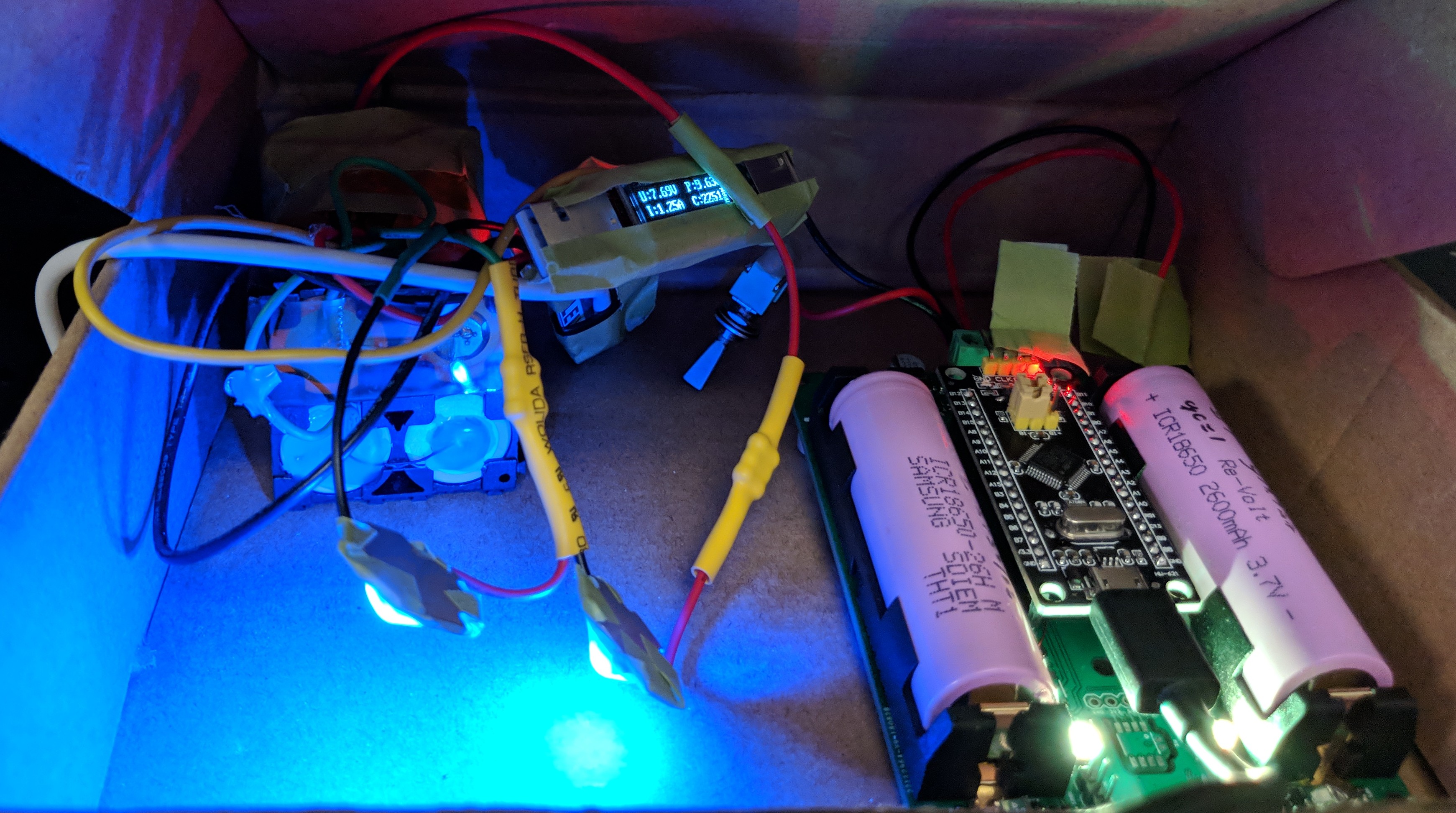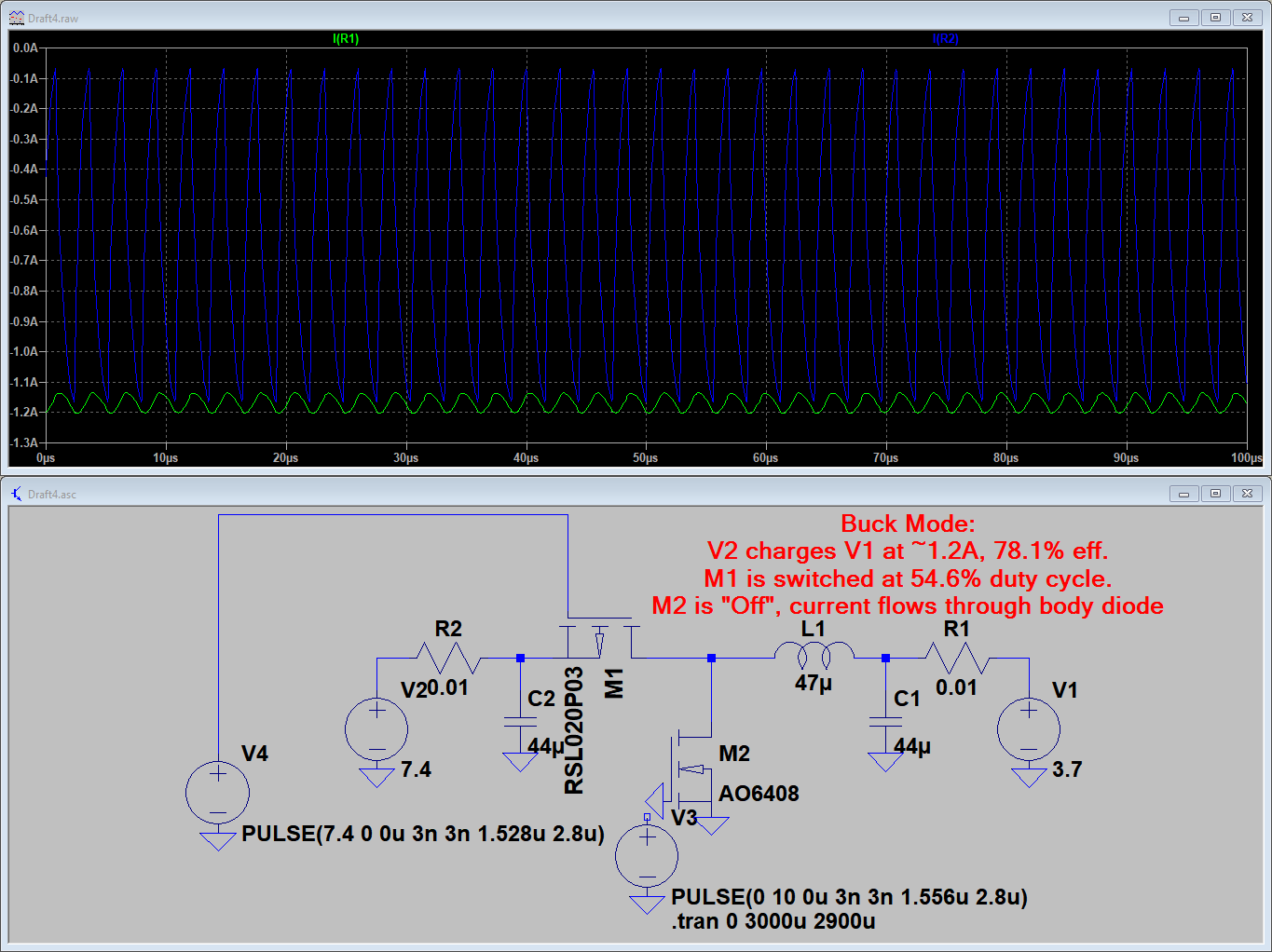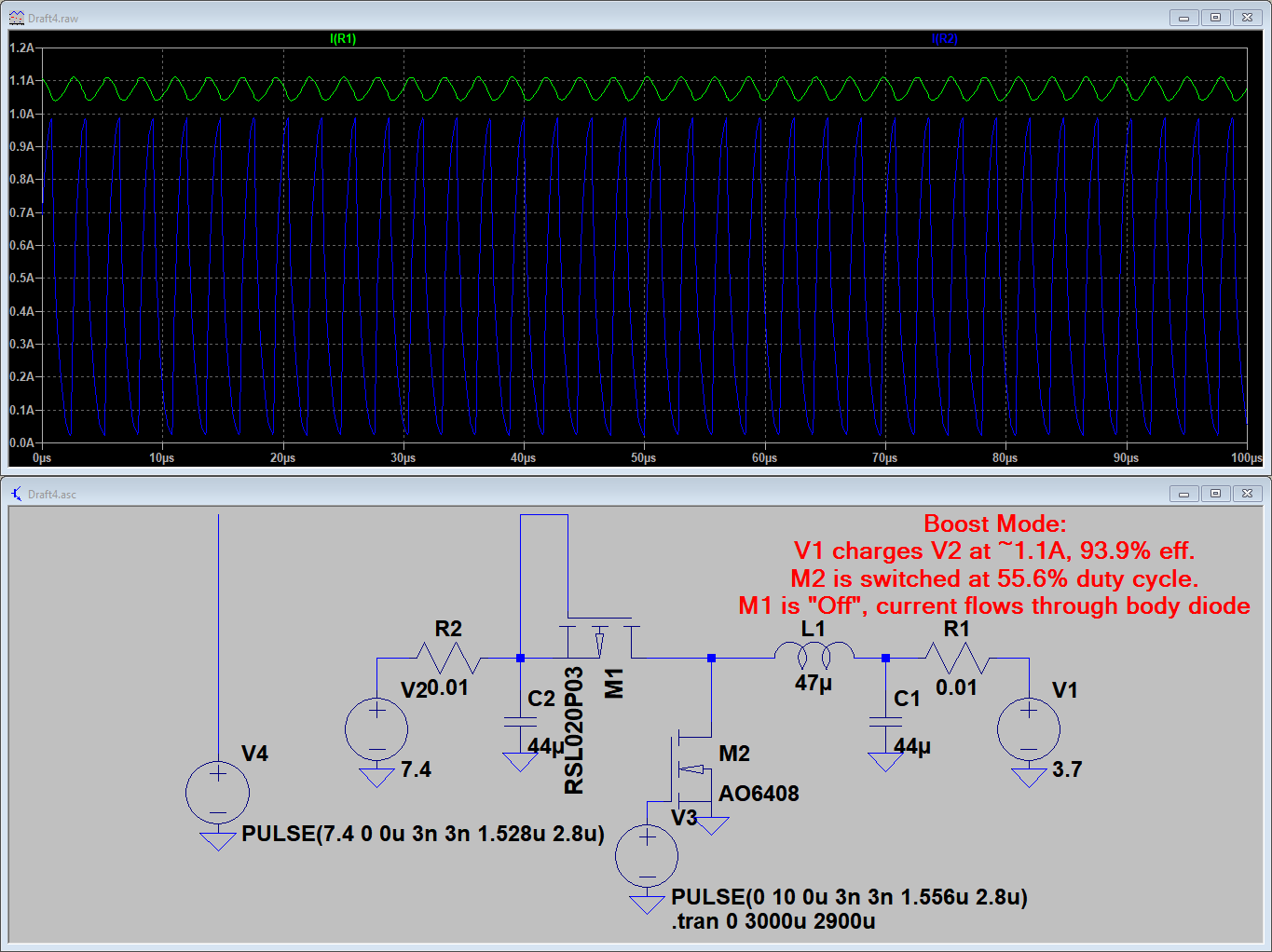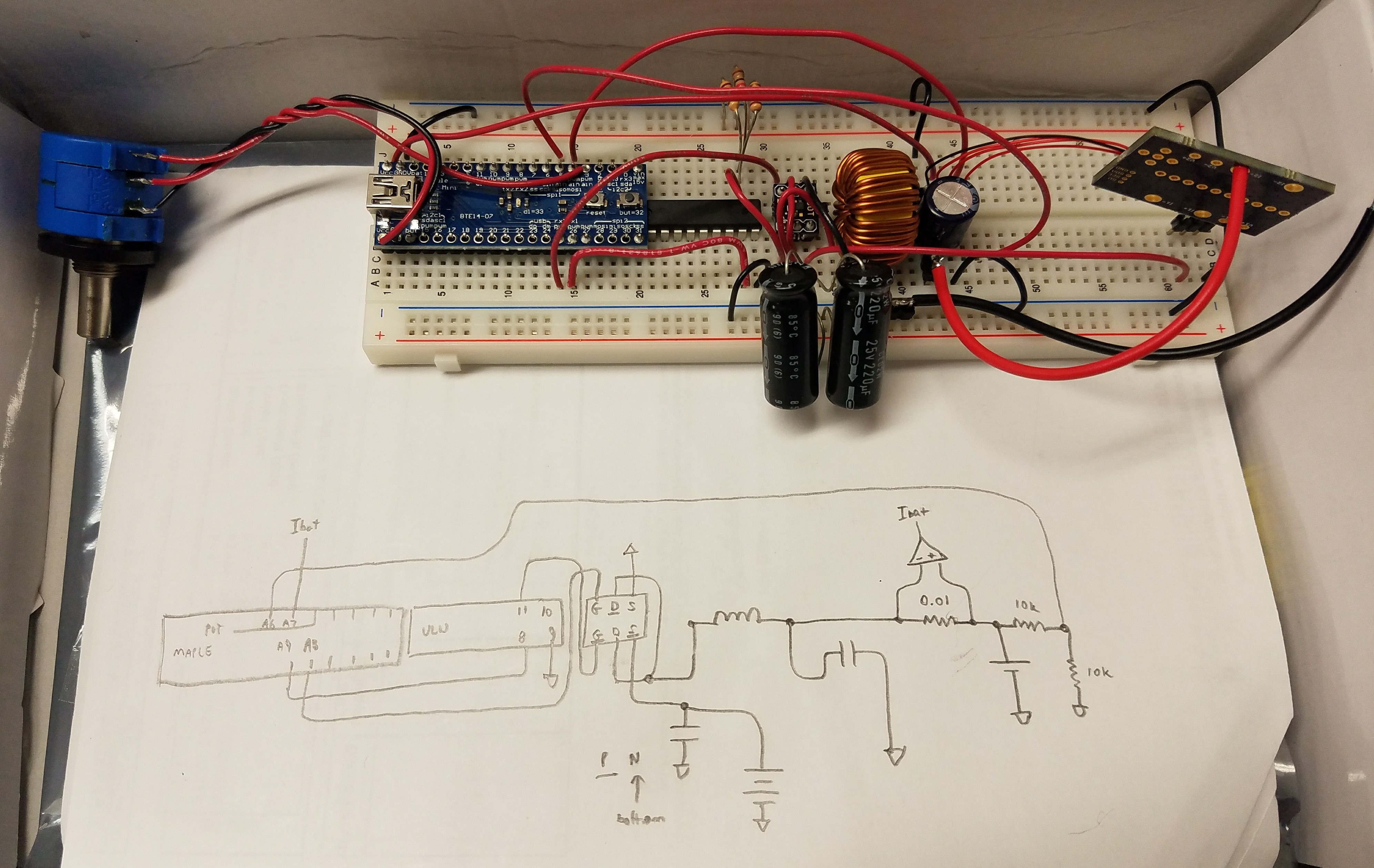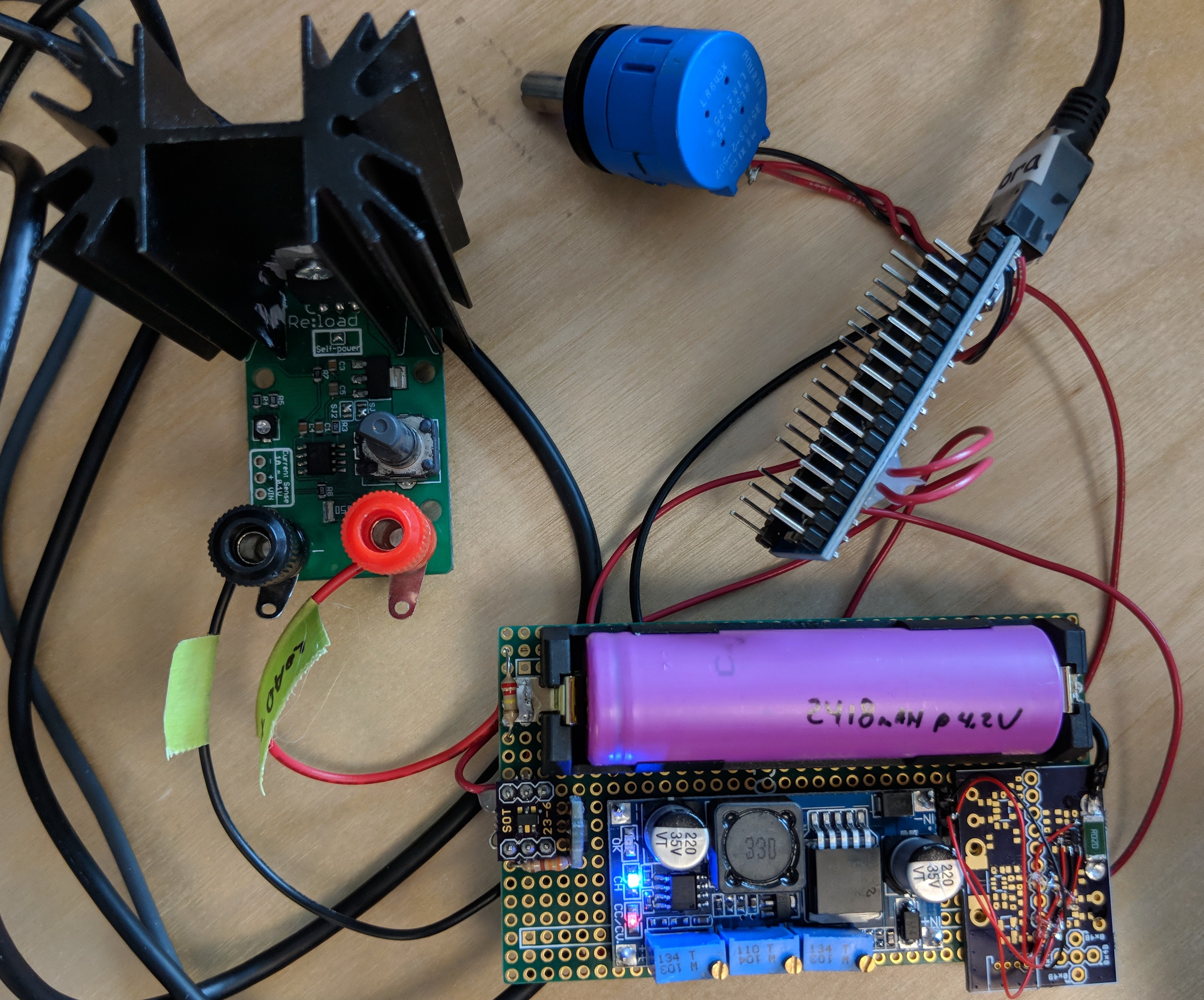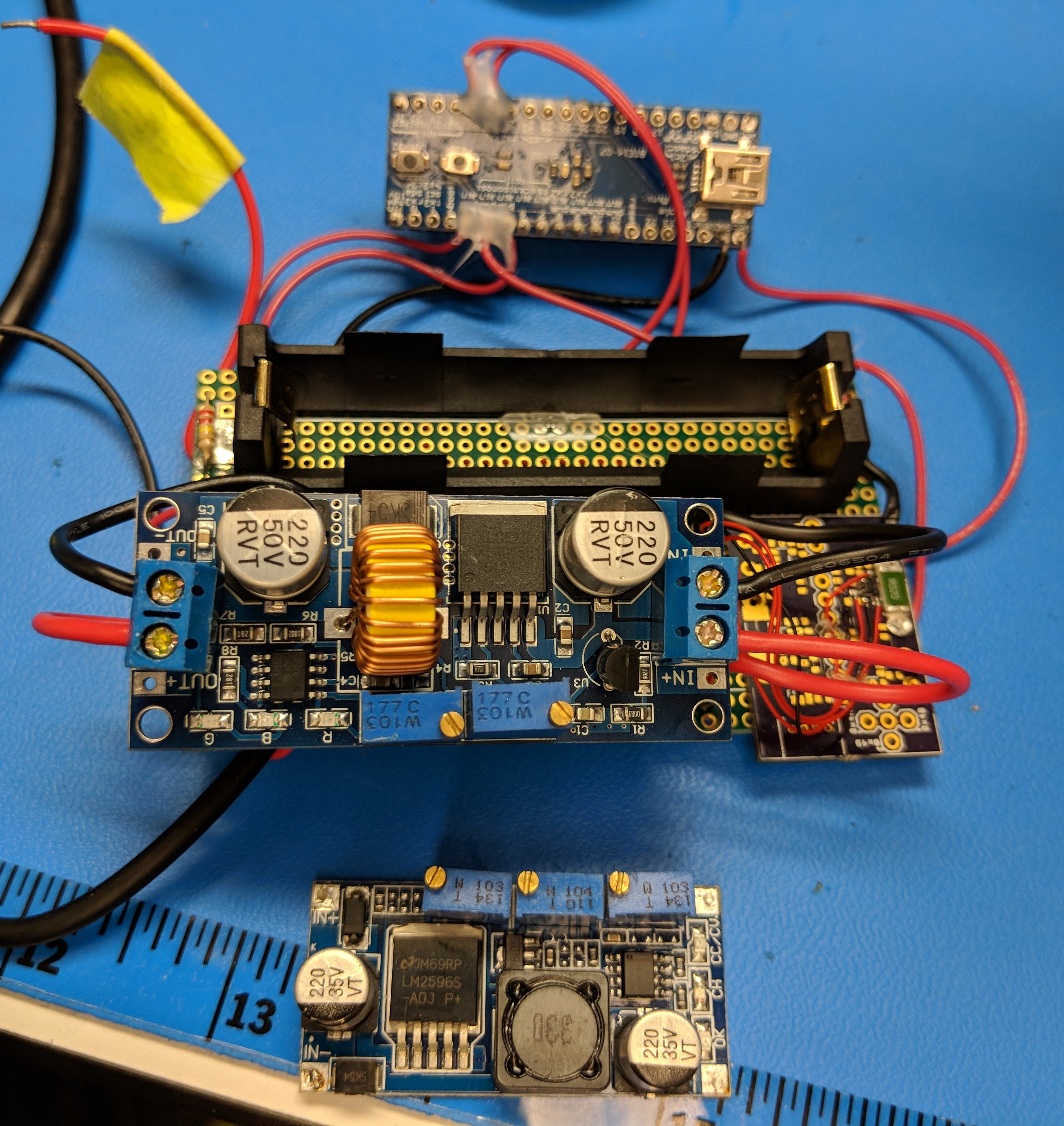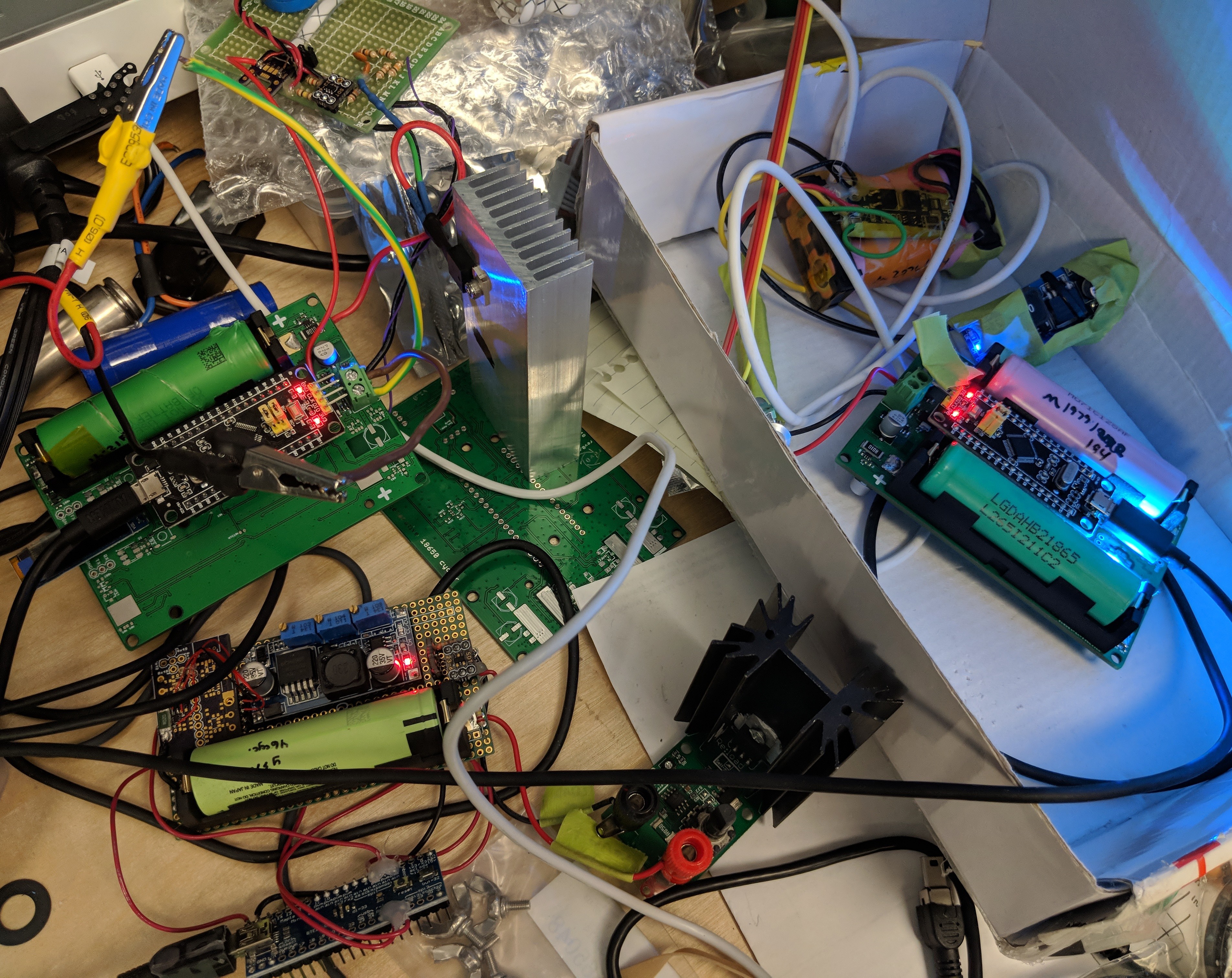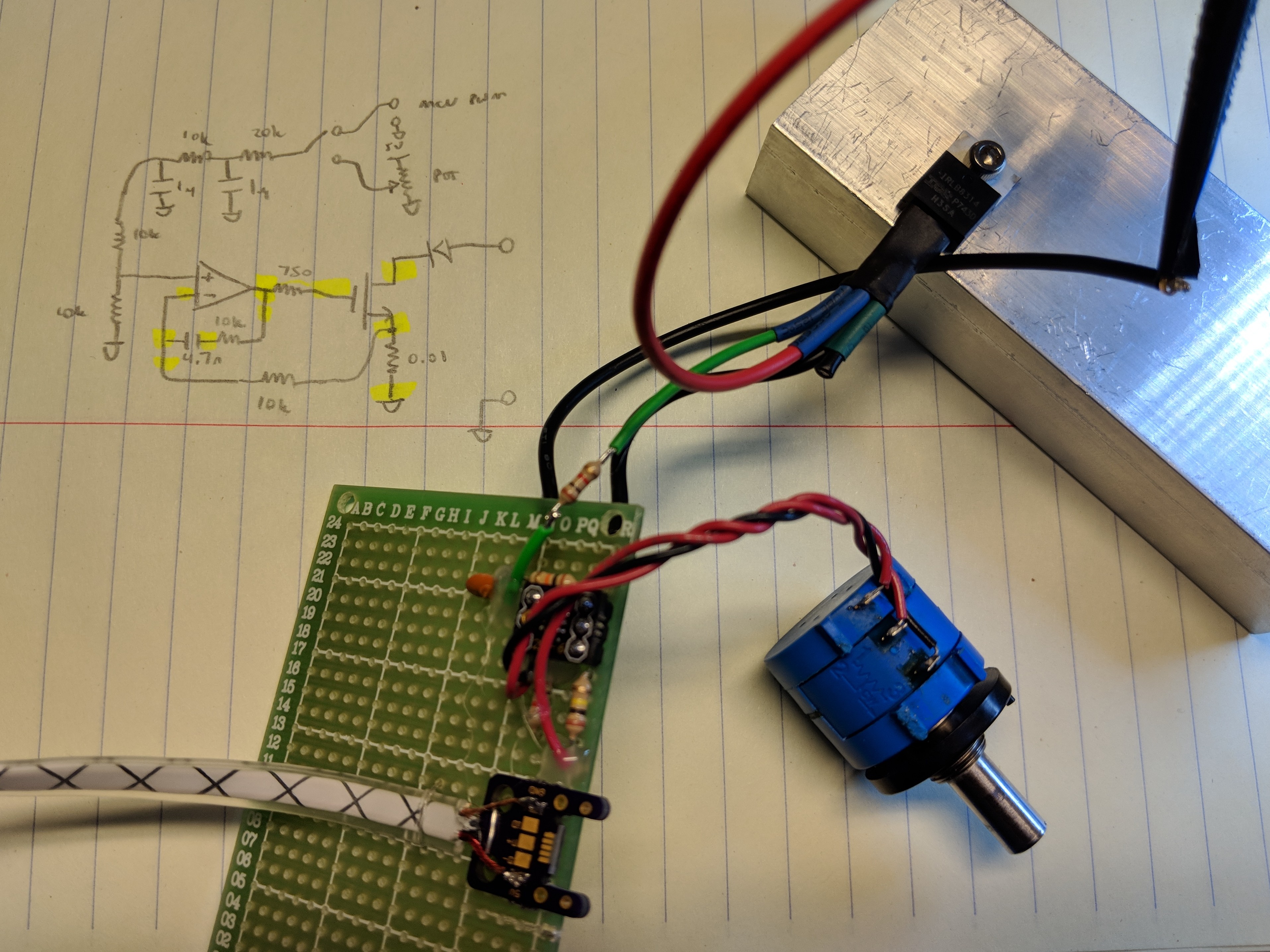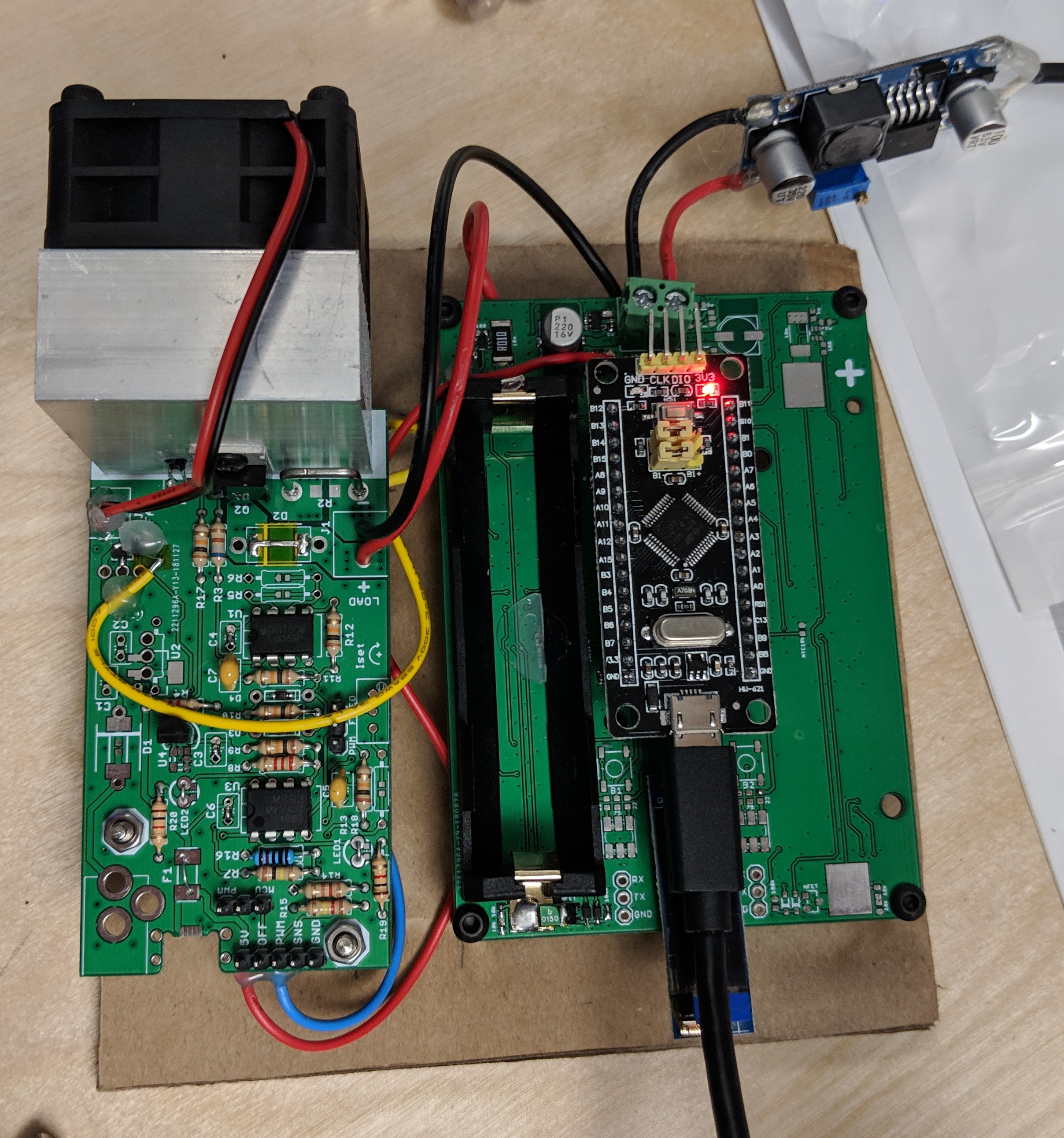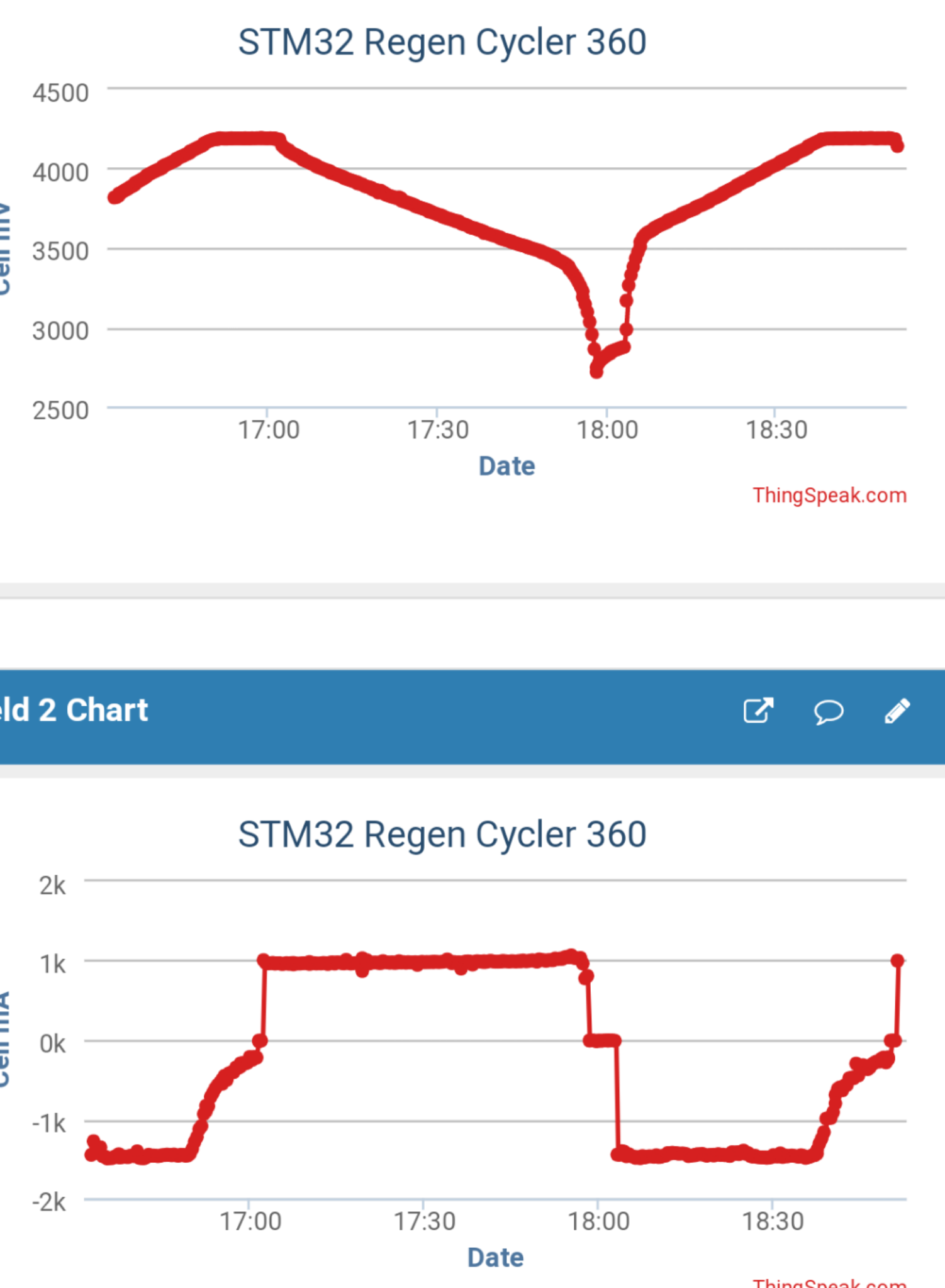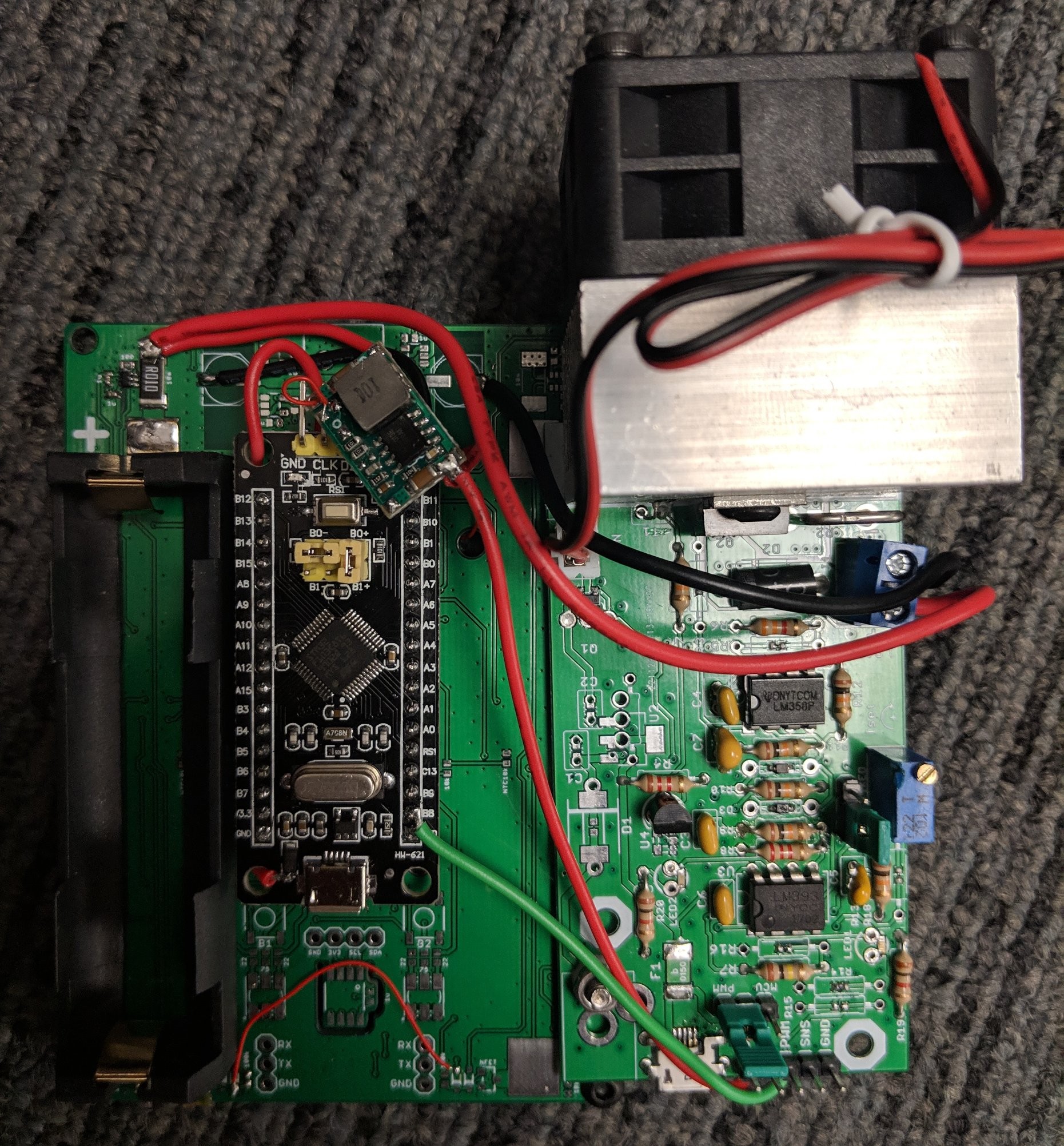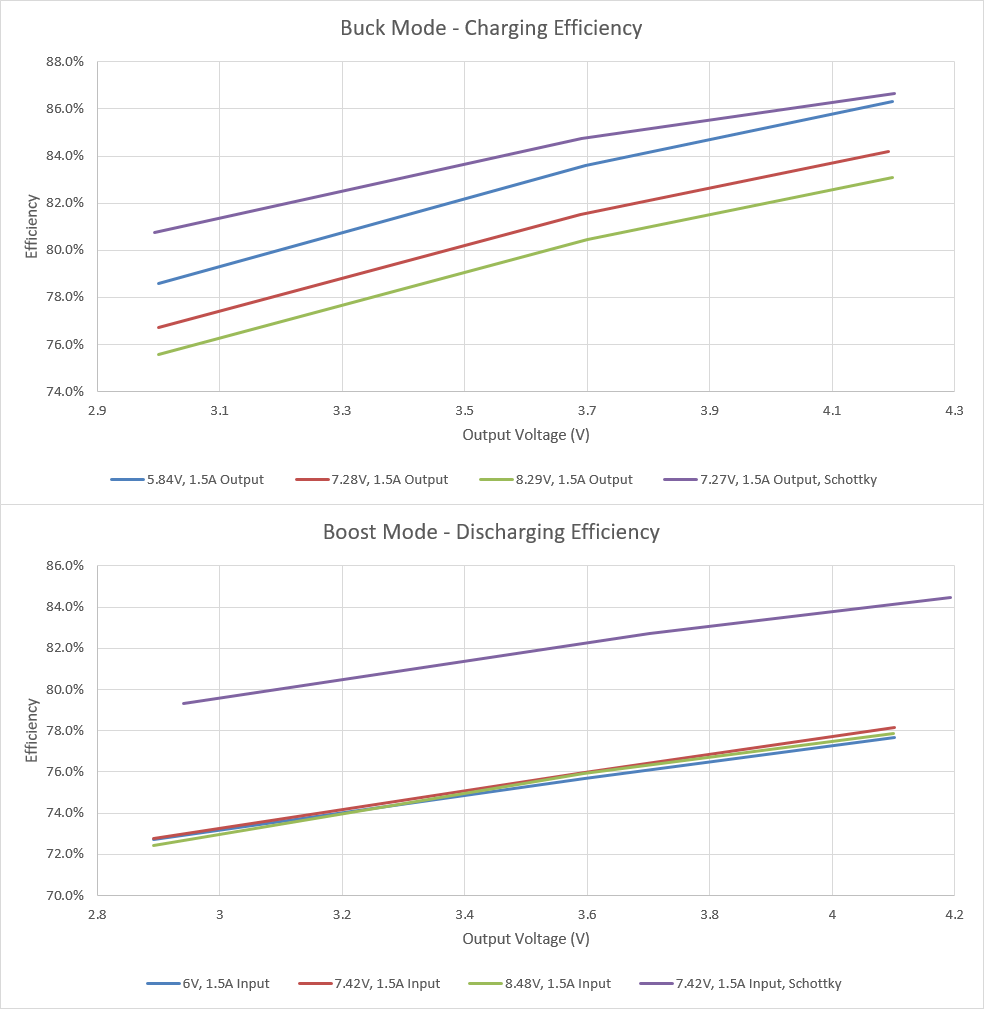CCR
This is a project to create a regenerative capable dual slot 18650 Li-* battery tester, which when used in conjunction with computer software or an additional ESP8266 module (yet to be implemented) can also graph the data in real time to Thingspeak or InfluxDB/Grafana for analysis.
List of Features
Version 1 - Regenerative Only
- Voltage Range (Charge): 0-4.35V
- Max Current (Charge): 1.5A
- Max Current (Discharge): 1.5A
- Sample Rate: 1 Hz (Reporting rate), 2 kHz (Loop/Integration rate)
- Efficiency: 84% (Buck/charge mode, average, 1.5A output), 82.2% (Boost/discharge mode, average, 1.5A output)
Version 2 - Regenerative Mode
High Power Variant
- Charge: Up to 5A (tbd)
- Discharge: Up to 5A (tbd)
Low Power Variant
- Charge: Up to 1.5A
- Discharge: Up to 1.5A
Version 2 - Non-regenerative Mode
High Power Variant
- Charge: Up to 5A (tbd)
- Discharge: Up to 5A (single channel), 3A (dual channel)
Low Power Variant
- Charge: Up to 1.5A
- Discharge: Up to 3A
Output Format
State List:
- 0. Battery Disconnected (Unused)
- 1. Battery Discharge
- Voltage < 2.75V?
- 2. Battery Disconnected
- Wait 5 minutes
- 3. Battery Charge
- Current < 50mA?
- 4. Battery Disconnect
- 5. Wait 1 minute
- 6. Measure IR
- 7. Measure IR
- Wait 10 seconds
- 8. Parking
Message Type List:
- 0. Cell 1 periodic status
- 1. Cell 1 end of discharge stats
- 2. Cell 1 end of charge stats
- 3. Cell 1 IR debug
- 4. Buffer pack voltage/system status
- 5. Cell 2 periodic status
- 6. Cell 2 end of discharge stats
- 7. Cell 2 end of charge stats
- 8. Cell 2 IR debug
| Message Type (Periodic Status) | Battery Voltage (mV) | Battery Current (mA) | Capacity (mAH) | Capacity (mWH) | Temperature (C) | State |
| 0 | 3752 | 1499 | 648 | 2565 | 23.6 | 1 |
| 5 | 3942 | -1454 | 980 | 3658 | 25.8 | 3 |
| Message Type (End of Discharge) | Battery Voltage (mV) | Battery Internal Resistance (mOhm) | Capacity (mAH) | Capacity (mWH) | Temperature (C) | State |
| 1 | 3015 | 149.3 | 648 | 2565 | 23.6 | 2 |
| 6 | 2975 | 45.2 | 2012 | 7518 | 27.3 | 2 |
| Message Type (End of Charge) | Battery Voltage (mV) | Battery Internal Resistance (mOhm) | Capacity (mAH) | Capacity (mWH) | Temperature (C) | State |
| 2 | 4109 | 105.4 | 980 | 3658 | 25.8 | 7 |
| 7 | 4103 | 48.4 | 1780 | 6507 | 28.4 | 7 |
Development
Breadboard Prototype
Early investigation of the concept started with determining the maximum PWM frequency and resolution the STM32F103 could produce, and how to size the inductor and capacitor accordingly to produce a 1.5A output with good current regulation. The best compromise of frequency and resolution was selected to be 360kHz with 200 steps, providing about 200mA/step of resolution in CC mode. This was simulated in LTSpiceIV to size the inductor and capacitor for the buck, chosen to be 33uH with 440uF of output capacitance. The buck circuit was assembled on a breadboard but ultimately did not work due to the high parasitics at the frequency used (360kHz).
COTS Cycler
For cycler software development (excluding the closed loop feedback and PWM, i.e. state machine and interface) a second prototype was built using a CC-CV 3A buck converter module and Re:load v2 constant current load connected to a Maple Mini and additional temperature sensing and current/voltage sensing circuitry.
This cycler is still in active operation testing Panasonic NCR18650B and LG F1L cells, the results of which as of 1/3/19 are below:
CCR v1.0
CCR Dev (Resistive Load)
The original single cell CCR v1.0 board was modified to use a constant current load made with an IRLB8713 MOSFET attached to a 100*40*20 heatsink controlled by an op-amp closed loop feedback circuit. The constant current load was later switched to an actively cooled 25W load (through-hole PCB version) and attached to a cardboard base.
CCR Mini 360
This was an investigation to use an off the shelf synchronous buck converter module to produce a regenerative charger/discharger by overriding the module's feedback node, injecting a voltage signal in to bias the module to higher or lower output voltage/current, which when biased lower than the attached battery's voltage would act as a synchronous boost converter, charging the buffer pack. This prototype was successful in concept but had poor regulation and performance, able to manage ~0.8-0.9A in discharge and ~1.3-1.5A in charge.
CCR Dev + Buck
This is another CCR Dev variant using a feedback modulated off-the-shelf buck converter for the charger, as opposed to the custom buck converter controlled directly by STM32. Originally it was built with a Mini-360 module but was later upgraded to an LM2596 module for up to 2A charge capability (originally limited to 1.3-1.5A like the CCR Mini 360 variant). This cycler was provided to SecondLifeStorage member Phizicks for Python code development.
CCR Dev + 6A Buck
A development board was built for the RT8298 6A buck converter. The board initially had a schematic error putting the diode on the output node instead of the switching node, and which killed the original RT8298 IC due to inductive spikes. It was rebuilt correctly, and during testing was found that it would shut down if the feedback node was too low. The code was modified to limit the feedback PWM from the MCU to minimum ~25% which resolved the issue, but limited the "range" of the control such that charge was limited to only 2A. This board was removed and re-built with an XL4015 module instead.
Heatsink Sizing
The cooling solution for the 2 MOSFETs that make up the discharging circuit is a 100x40x20mm aluminum extruded heatsink with 11 fins, and a 5V 40x40x20mm fan. Results are as follows (tested at ~21 C ambient):
- 4A 4.2V (16.8W) (2A x2) - 65 C max on FET body, approx. 71.3 C Tj
- 5A 4.2V (21W) (2.5A x2) - 75 C max on FET body, approx. 82.9 C Tj
- 6A 4.2V (25.2W) (3A x2) - 84 C max on FET body, approx. 93.5 C Tj
- 7A 4.2V (29.4W) (3.5A x2) - 93 C max on FET body, approx. 104 C Tj
- 4A 4.2V (16.8W) (4A x1) - 79 C max on FET body, approx. 91.6 C Tj
- 5A 4.2V (21W) (5A x1) - 93 C max on FET body, approx. 108.8 C Tj
Electronics
Buck Converter (Charger)
...
Boost Converter (Discharger, regenerative)
...
CCR v1 Performance Evaluation
Constant Current Load (v2 Discharger, resistive)
...
Microcontroller
The CCR uses an STM32F103C8 microcontroller in the form of a "blue pill" board, which includes crystals, header pins, USB plug, and other supporting circuitry, and allows for the MCU to be swapped out in case of damage.
Hardware Revisions
Revision 1.0
This is the first revision of the CCR, which only natively supports regenerative discharging mode.
Errata:
- Pin A11 was used for the P-channel MOSFET control on cell 2, which is not usable for this function (pin is natively used as USB D+).
- ...
Revision 2.0
This is the second revision of the CCR, which supports regenerative discharging mode (optional) as well as constant current discharging mode, and increased current capability of up to 3A in charge, and 5A (single channel)/3A (dual channel) in discharge.
Change List:
- Added pull up/pull down resistors to "safe" the device when power is removed or reprogramming is taking place
- Added PTCs to cell and buck circuit to prevent shoot through or shorting of the cell which led to many N-channel MOSFETs being destroyed on the prototype
- Thermally isolated temperature sensor NTC from PCB ground plane by thin traces and cutout
- Added silkscreen below SMD cell holder for better reliability against cell shorting of bare cells
- Added pads and BOM option for external voltage sense wires for better accuracy in high current operation
- Added SOIC-8 MOSFET placement options for higher current FETs to accommodate 3-6A charge capability
Errata:
- ...
PCB Files
Here is the Eagle schematic file for the CCR v1.0: http://rev0proto.com/files/tbd.sch Here is the Eagle board file for the CCR v1.0: http://rev0proto.com/files/tbd.brd
Enclosure
The enclosure for the CCR v2.0 was created in Fusion 360 and is made up of x pieces which can be 3D printed and assembled with M3 screws.
Here are the Fusion 360 files for the CCR v2.0 enclosure: http://rev0proto.com/files/tbd.zip
Code
Full source code for the project can be found here: http://rev0proto.com/files/x.zip
Videos
<HTML5video type="youtube" width="400" height="300" autoplay="false">1SHY4jAfTcM</HTML5video>
Photos
Total Project Cost
| Component | Cost | Source |
| Enclosure (Top) | $19.03 | Shapeways |
| Enclosure (Bottom) | $22.33 | Shapeways |
| Enclosure (Buttons/Switch/Cover/Shipping) | $20.65 | Shapeways 123 |
| PCB | $8.40 | OSH Park |
| Geiger Tube | $7.44 | eBay |
| Battery | $4.04 | HobbyKing |
| Components | $25.86 | Digi-Key |
| Total Price | $107.75 |
